| THIS WEEK'S ARTICLES |
| The Market Message |
| GameStop Mania May Be Contributing to Selling |
| by John Murphy |
Stock indexes remain under pressure again today and are pressuring moving average lines. Chart 1 shows the Dow Industrials falling below its 50-day moving average for the first time since early November. It may be headed for a test of a potential support line drawn over its early September high. Chart 2 shows the S&P 500 in danger of falling below its 50-day line as well. Wednesday's message showed its daily MACD lines turning negative which warned of more selling to come. Its 14-day RSI line in the upper box has also fallen below its 50-day line which shows a weakening of momentum. It may be heading toward its early September high as well. Chart 3 shows the Nasdaq Composite Index falling below its 20-day average today. It appears headed for a test of its 50-day average (blue arrow). Its daily MACD lines have turned negative.
All eleven sectors are in the red today with the biggest losses in energy, technology, cyclicals, and industrials. Defensive stocks like utilities, REITS, and staples are holding up a little better.
Most of the week's media coverage has been concentrated on the casino type trading taking place in GameStop and a dozen other stocks, and the battle taking place between those heavily-shorted stocks held by hedge funds and new buying by retail investors pushing those stocks sharply higher. Some have suggested that type of trading is symptomatic of bubble-like conditions in the stock market. Others have suggested some forced selling by those hedge funds has contributed to this week's stock selling. It's hard to say whether any contagion between the two is actually taking place. But it seems safe to suggest that the casino-like conditions surrounding GameStop may be causing some of the short-term nervousness in the broader stock market.
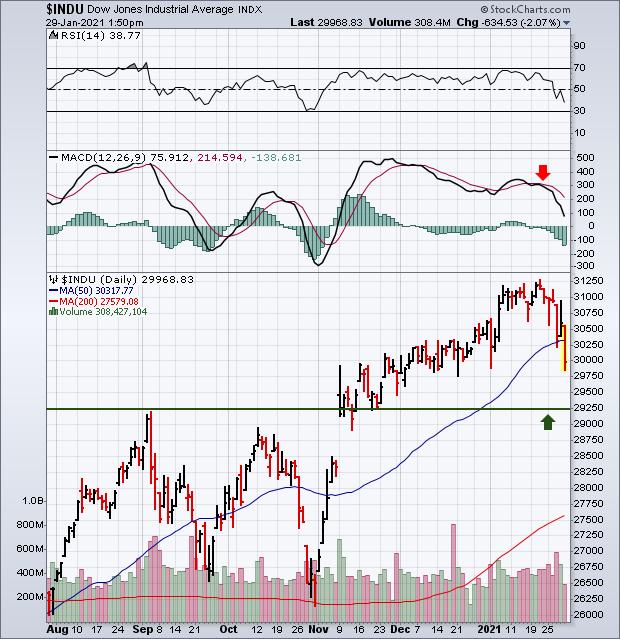 Chart 1 Chart 1
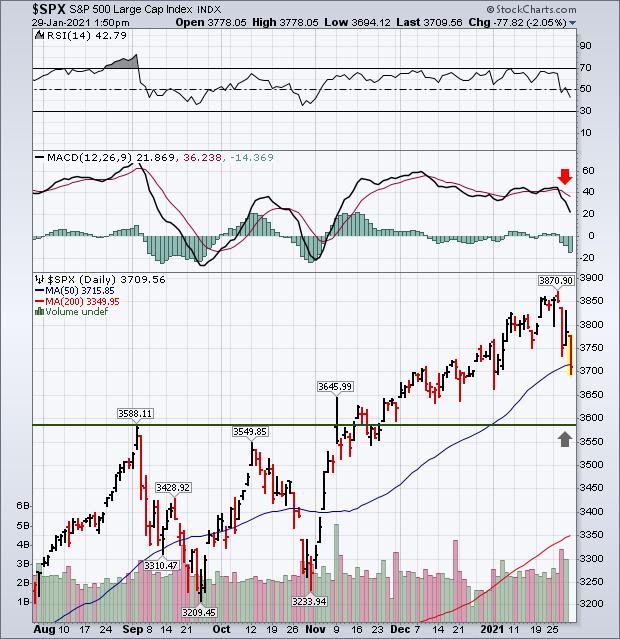 Chart 2 Chart 2
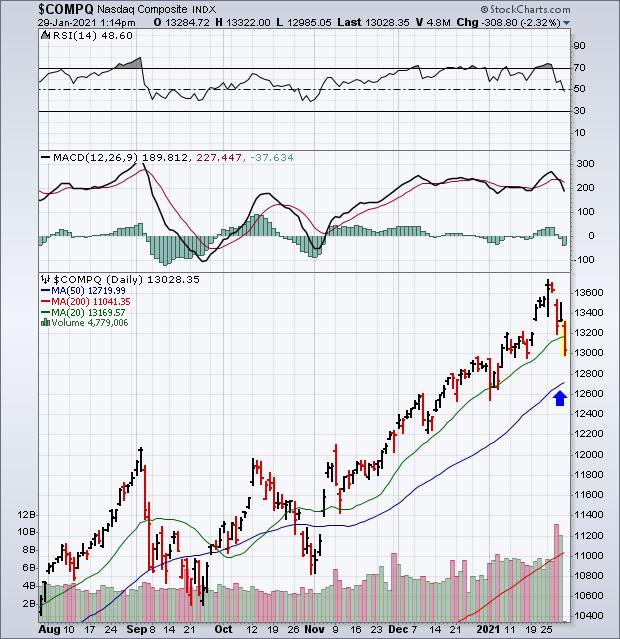 Chart 3 Chart 3
Editor's Note: This is an article that was originally published in John Murphy's Market Message on Friday, January 29th at 1:53pm ET.
|
| READ ONLINE → |
|
|
|
| The Mindful Investor |
| Advance Decline Lines Flash Warning |
| by David Keller |
 I've spoken recently of the bearish divergences emerging from breadth indicators, including the anemic new 52-week highs list, as well as a breakdown in the percent of stocks trading above their 50-day moving averages. I've spoken recently of the bearish divergences emerging from breadth indicators, including the anemic new 52-week highs list, as well as a breakdown in the percent of stocks trading above their 50-day moving averages.
As we recorded Friday's episode of The Final Bar, it appeared that the market weakness into the closing bell could trigger further deterioration in breadth readings.
After reviewing the final breadth readings on Friday evening, I have adjusted one of my key market breadth charts from 100% bullish to 50% bullish/50% neutral. Here, we'll review why this change is a significant one, and what we're looking for to rotate to a bearish breadth reading.
Market tops often begin with bearish divergences, both from breadth indicators like the ones we've mentioned above as well as momentum indicators like RSI. In fact, one of the most telling bearish signals in February 2020 was the lower peak in the cumulative advance-decline lines as the S&P 500 continued on to higher highs.
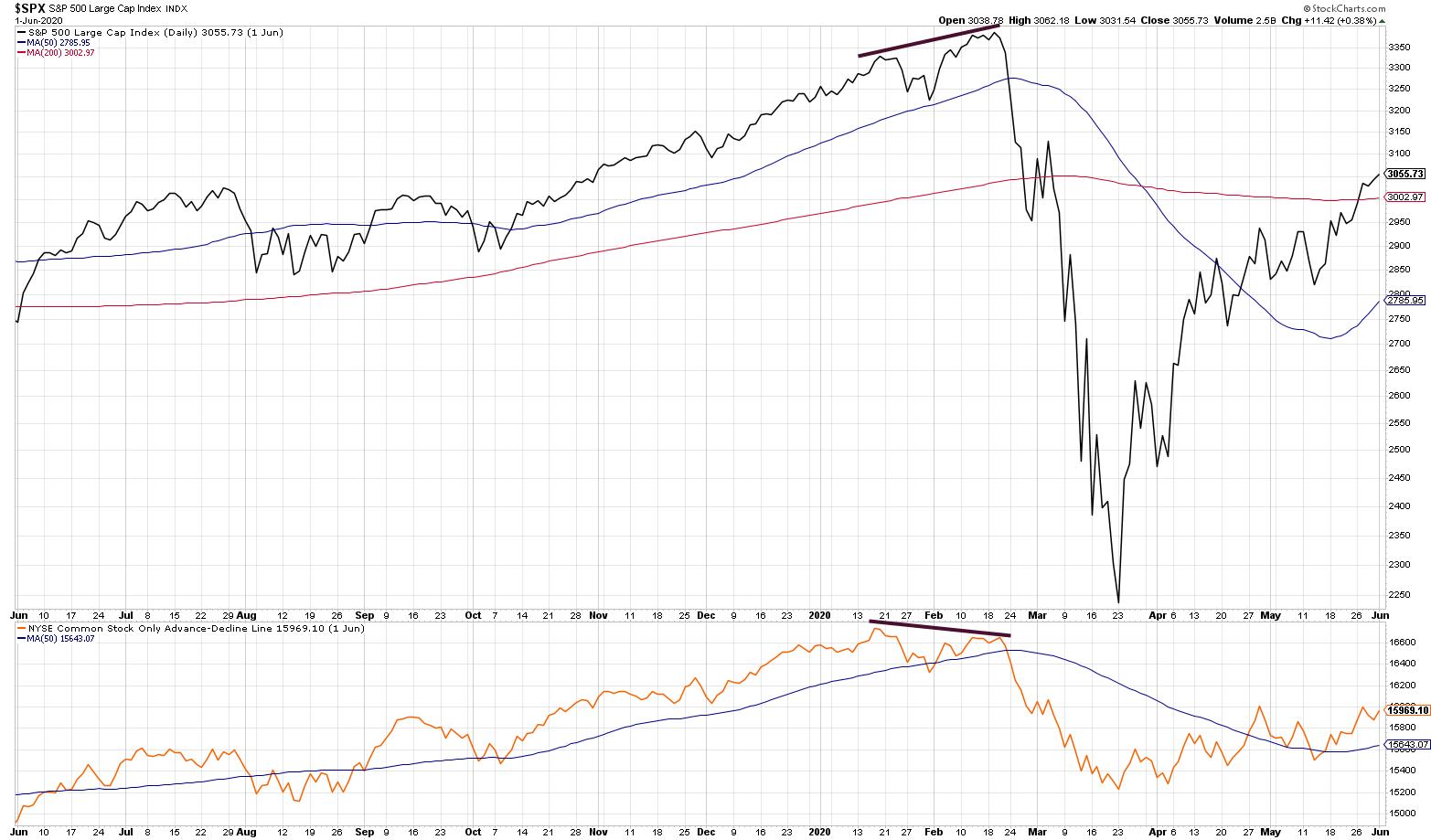
The lower peaks in the advance-decline lines were a cause for concern, but the price and breadth lines all breaking down were what finally confirmed the downtrend. This is a fantastic lesson in the value of using a mix of leading indicators (weakening breadth and momentum on higher prices) and lagging indicators (price breaks down through support).
Looking at the current breadth picture, we can see that none of the four advance-declines shown have established a lower high. All have continued to make new highs along with the S&P 500 index. So we have not seen the bearish divergence - yet.
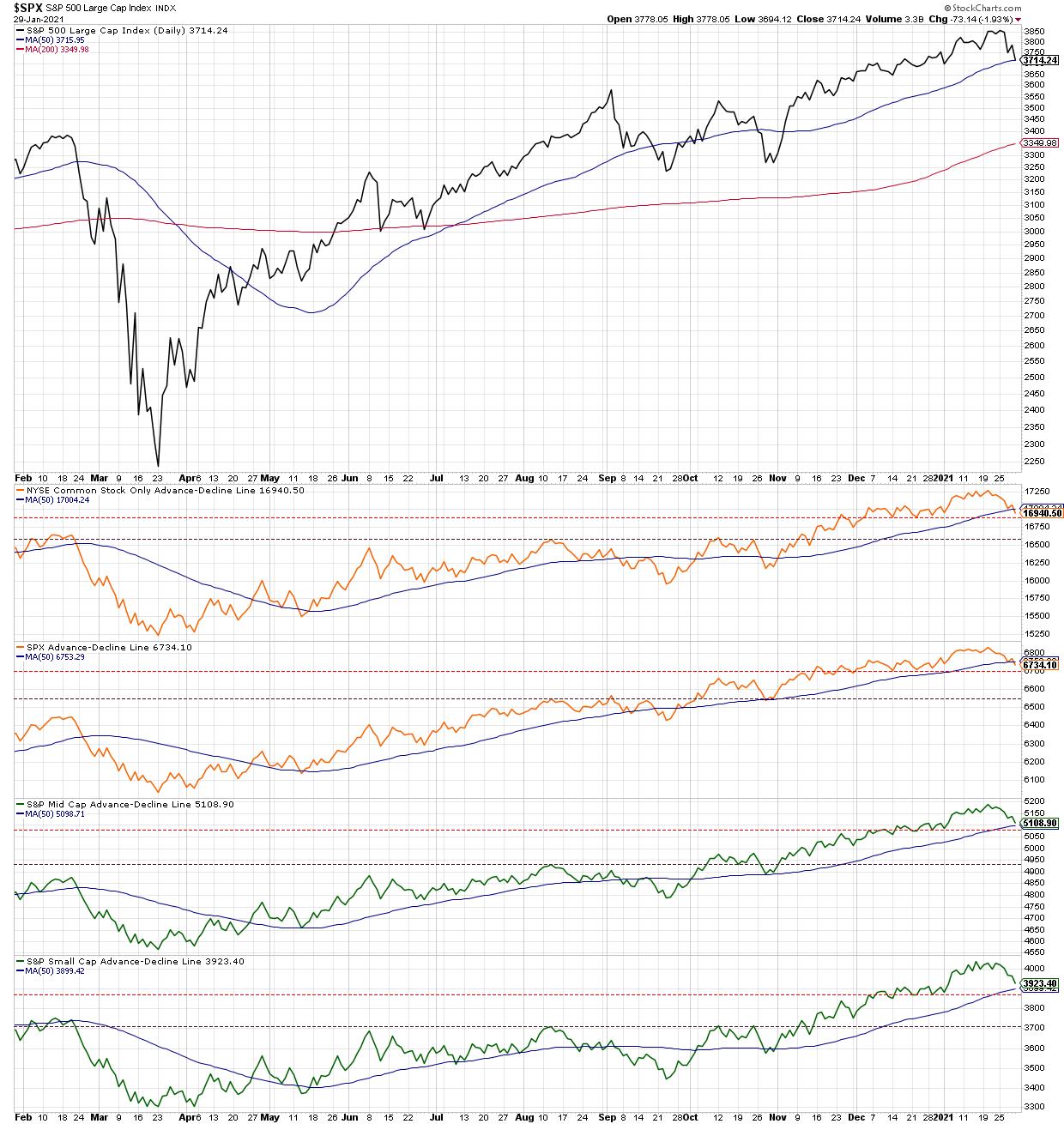
The color-coded advance-decline lines represent the NYSE (common stocks only), S&P 500, S&P Mid Cap and S&P Small Cap indexes. The colors themselves are based on my (quite subjective) evaluation of their trend and signal, using a simple stoplight approach. Based on this week's pullback, the two A-D lines that broke their own 50-day moving average deserve a neutral rating, with the other two (which have remained above this basic smoothing mechanism) remain in bullish green.
What would cause me to turn these indicators red, indicating a higher likelihood of a selloff? I've added red horizontal lines, which recognize the most recent swing low in the breadth line. If they remain above this support level, then the breadth conditions would suggest limited downside from here and a shallower price correction.
This approach is simple and is based on the simplest part of the technical toolkit: our ability to define uptrends and downtrends using swing highs and lows. As much as we love to complicate the picture with sophisticated analysis and details, I've often found that simplest approaches tend to stand the test of time.
By the way, earlier I mentioned the bearish divergences with momentum indicators. Here's the daily S&P 500 chart with what is definitely a bearish divergence with RSI.
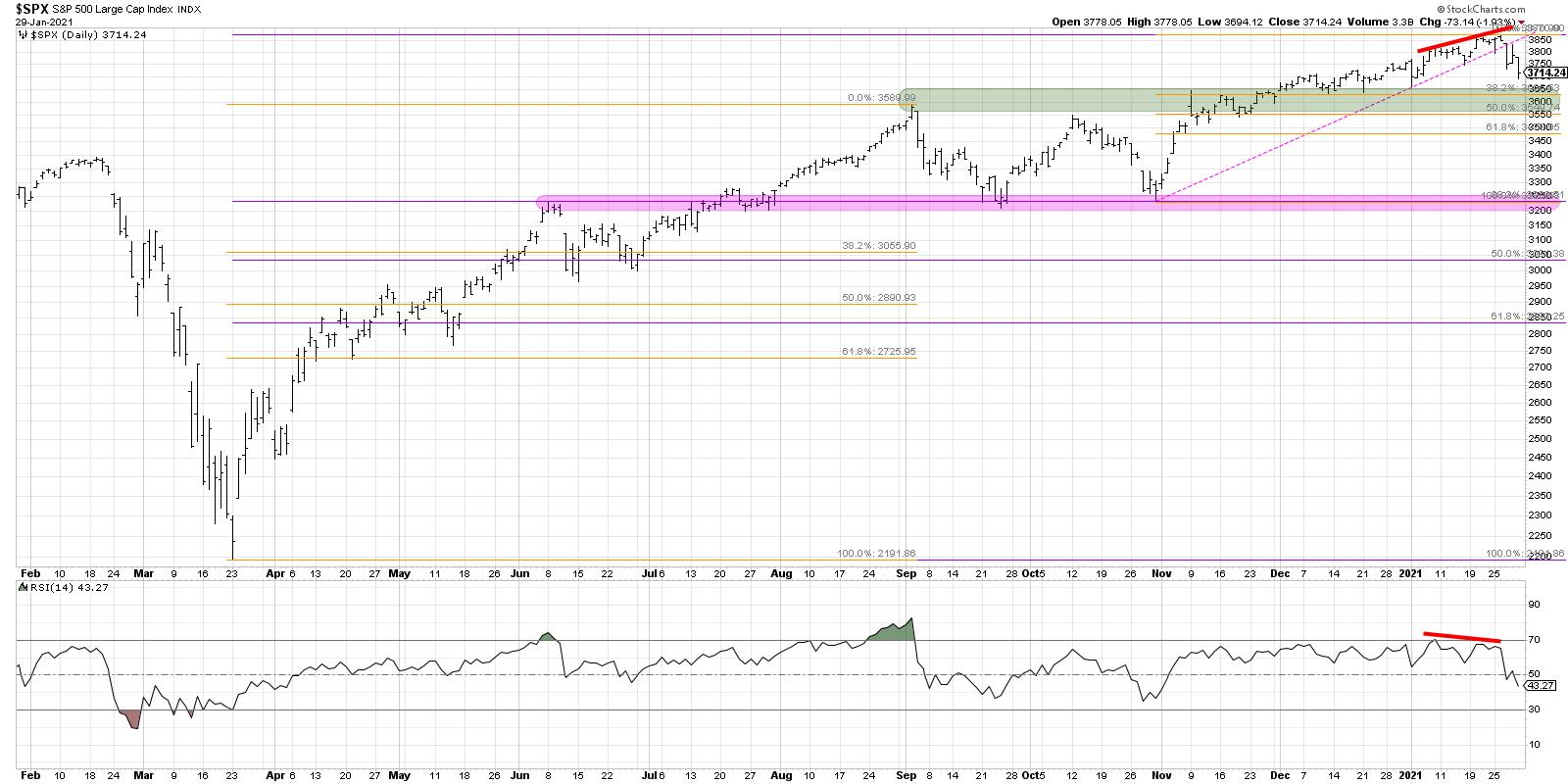
What's even more concerning are the similar divergences in high-flying leadership names like Tesla (TSLA) and Plug Power (PLUG), both of which spent much of last year at the top of the Large Cap and Mid Cap SCTR rankings, respectively.
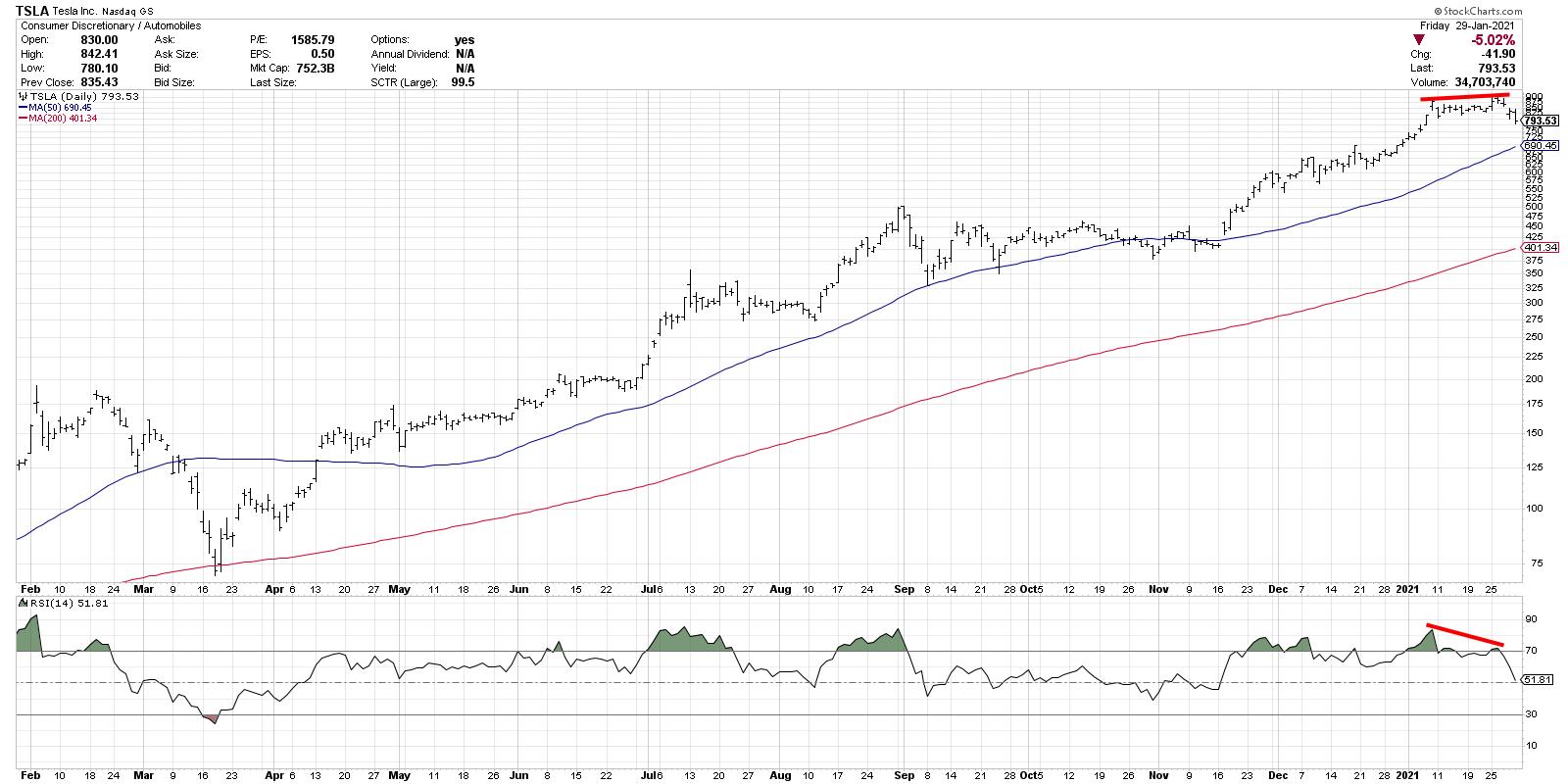
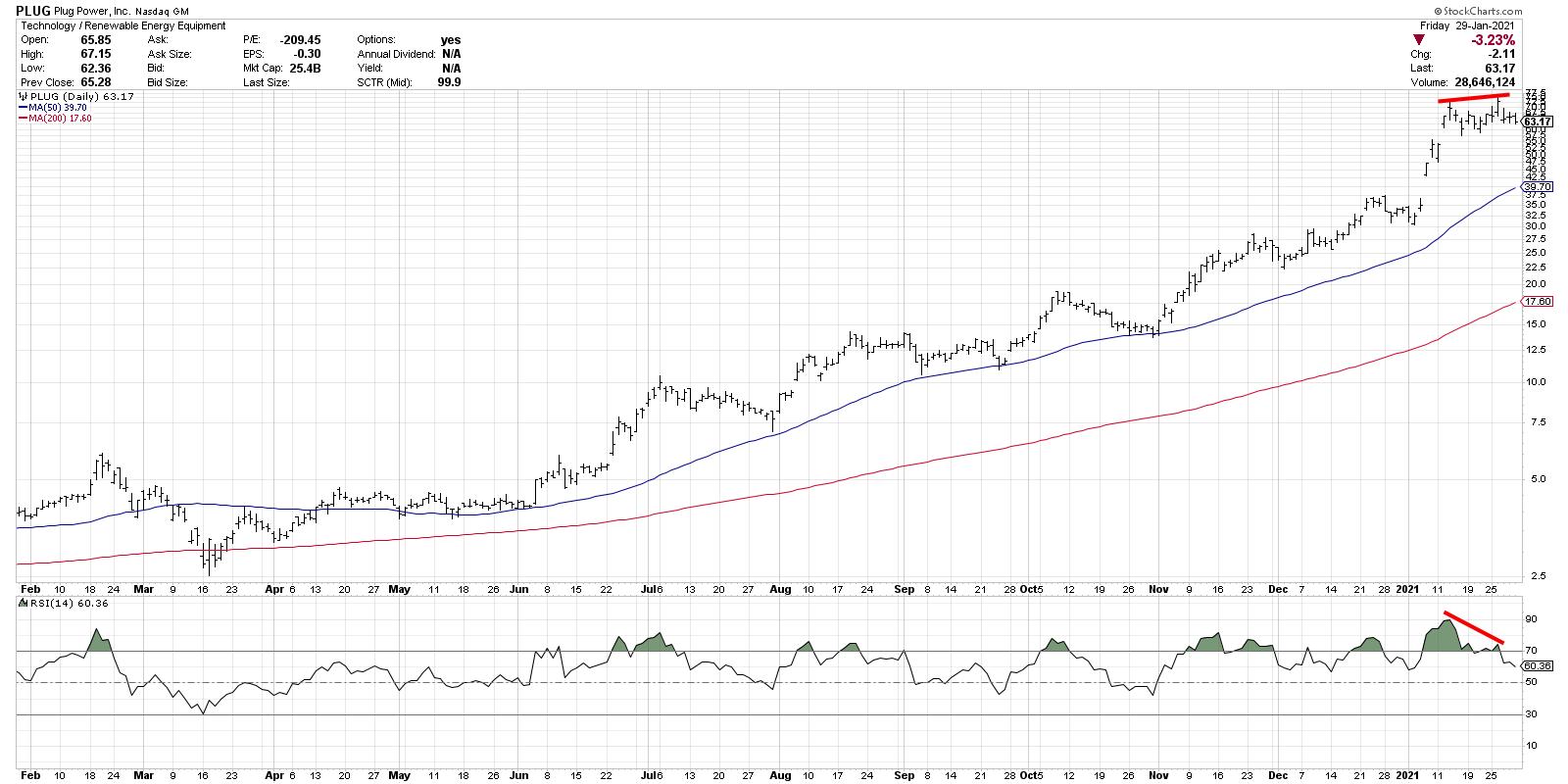
Can the market continue higher given all of this negativity? Of course. To negate this overall bearish thesis, I'd need to see the following:
- The S&P 500 bounce off its 50-day moving average and a return to previous highs.
- Cumulative advance-declines turning back higher and making further new highs.
- Stocks like TSLA and PLUG shrugging off bearish momentum divergences and continuing a pattern of higher highs and higher lows.
Until then, the path of least resistance for stocks is lower.
RR#6,
Dave
David Keller, CMT
Chief Market Strategist
StockCharts.com
Disclaimer: This blog is for educational purposes only and should not be construed as financial advice. The ideas and strategies should never be used without first assessing your own personal and financial situation, or without consulting a financial professional.
The author does not have a position in mentioned securities at the time of publication. Any opinions expressed herein are solely those of the author, and do not in any way represent the views or opinions of any other person or entity.
|
| READ ONLINE → |
|
|
|
|
|
| Trading Places |
| STOP Looking For Reasons to Exit The Best Bull Market of Our Lifetime |
| by Tom Bowley |
Just stop.
Listen, the two key drivers to the long-term direction of the stock market are (1) earnings growth and (2) monetary policy. That's it. The rest is completely noise that you need to tune out.
Most humans are innately pessimistic. It's how we're wired. And it shows every single time I look at an article headline. We love bad news. We love the train wreck. We can't get enough of it. Well, don't let that faulty human characteristic drive your stock market thinking. Hey, it's your financial future, so do what you think is right.
But here are the facts.
The Fed Could Not Be More Dovish
Did you hear Fed Chair Powell this week after the latest FOMC meeting? This is what I heard in summary form. The Fed believes growth could slow. Do you understand what that means in terms of future Fed policy? They will do whatever is necessary to support future growth. That means interest rates, which are already near historic lows, will remain that way for the foreseeable future. This is the only time in my lifetime that I've seen interest rates at these levels, which is incredibly bullish for U.S. equities. We're a debt-driven society and borrowing costs have NEVER been cheaper. STOP FIGHTING THIS.
We're also in line for more government spending. Say what you want about it, but it increases economic activity, thereby increasing profits for U.S. companies. Janet Yellen, former Fed Chair and now U.S. Treasury Secretary, is calling for more stimulus, as is Congress. Think about what more stimulus, a potential infrastructure package and a dovish Fed willing to do almost anything to re-inflate our economy will mean to future earnings growth of U.S. companies. Fed Chair Powell is on record saying that interest rates will remain low into 2023. That's at least two more years of the open candy jar! But even higher rates, when they emerge, from these ridiculously low levels won't disrupt the growth over the next several years.
And Then There's Earnings...
Many naysayers constantly point to the high PE ratio in the market today and continue to compare it to other major market tops. Again, it's our pessimistic nature. There are a couple things that must be understood here:
- During a historically-low interest rate environment, there are few investing alternatives to equities, triggering higher PE ratios (trust me, it's okay). Investors will be pay up for earnings.
- Rapidly-rising earnings forecasts will lower those current "scary" PE calculations.
I spent two decades in public accounting, mostly on the audit side. But I was involved in business valuations for clients - and nothing sends valuations higher than the combination of strong earnings growth and low interest rates. High growth rates rapidly expand future profit scenarios, and low interest rates exponentially increases the value of that future earnings growth when you discount it back to the present day. It's fairly simple math that Wall Street understands, while many other market pundits simply do not. The perma-bears most definitely don't understand it.
So where is this earnings growth going to come from? Well, do your research. It's right in front of us. Here's a quick little snapshot of the earnings summary the past two weeks:
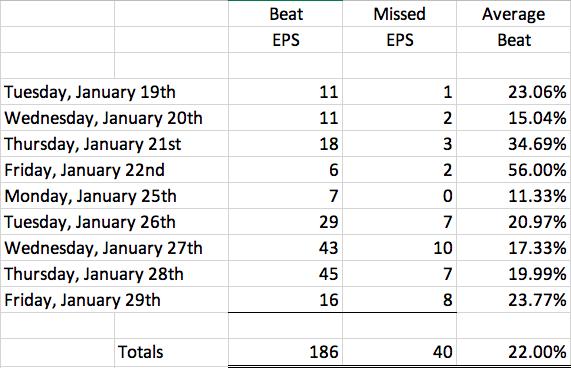
The above analysis was based on free information that I summarized from zacks.com. Among companies with market caps greater than $5 billion, 186 out of 226 have beaten consensus estimates and the average beat has been by 22%!!! It's also worth noting that the "misses" include companies that simply matched expectations. The average beat has been in double digits every single day the past two weeks. Companies aren't just skating by estimates, they're blowing them out of the water! We haven't even seen the effect of the pent-up demand that's about to be unleashed across the globe when this pandemic is behind us. Growth will be explosive and future earnings forecasts will be raised - all while the Fed sits on its hands and interest rates remain extremely low.
Last week, Q4 GDP's initial reading came in at 4%. Folks, we still have restrictions in place across the country (across the globe for that matter). We have not seen ANNUAL GDP above 4% in any year this century. It's going to happen in 2021. I believe we'll see 5% or more. That kind of economic expansion, coupled with an accommodating Fed, is going to result in accelerating earnings across the board.
Go ahead and short this market if you want. I'll pass.
We're in a Secular Bull Market
Stop fighting it and join one of the best stock markets of our lifetime. We're embracing it at EarningsBeats.com and that's the primary reason we can boast the following results in our portfolios (through Thursday's close):
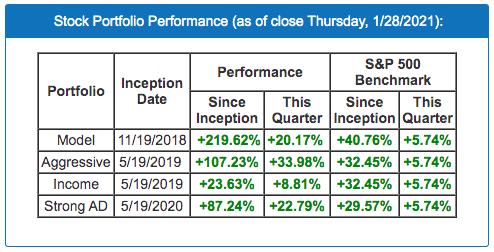
The rally off the 2009 lows is nowhere near complete. This secular bull market actually began in April 2013, when we cleared the double top on the S&P 500 from 2000 and 2007. It's always good to take a step back and look at the Big Picture, and I see nothing but long-term strength:
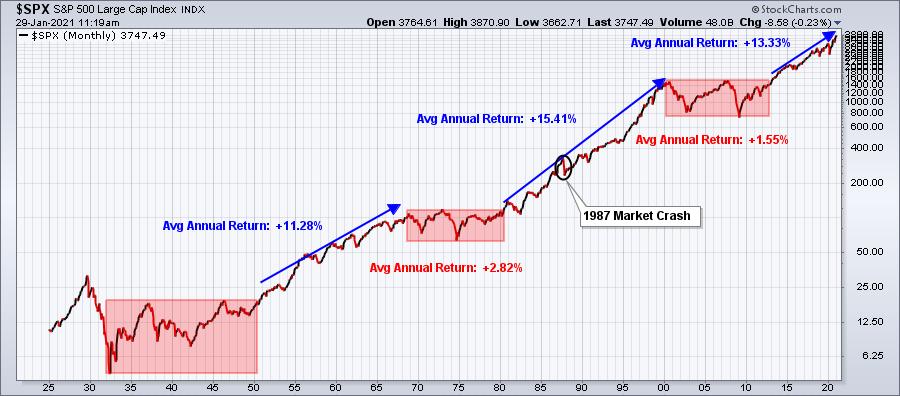
Think about this for a second. We've endured a lengthy trade war and a 100-year pandemic in the past two years and we're sitting at an all-time high. You need to see the significance of that. The market is shaking this off just as it shook off the 1987 market crash. It's how secular bull markets work. Weakness doesn't last. Instead, it presents MASSIVE opportunities.
The Biggest Event of 2021
I'm hosting an event tomorrow morning, Saturday, January 30, 2021, "A Day in the Life of EarningsBeats.com". I'll be providing an in-depth analysis of every facet of our business. It's being held for two reasons:
- A refresher for current EarningsBeats.com members to better utilize our research and educational platform.
- To introduce the StockCharts.com community to our vast number of products and services.
This is a FREE event, but you'll need to be an EB Digest newsletter subscriber (also free) to receive the room instructions tomorrow morning. I'll also be highlighting the significance of January performance relative to the balance of the year (the "January Effect"). I believe you'll find this information quite interesting. CLICK HERE for more information on the event and to sign up for our EB Digest. There is no credit card required and you may unsubscribe at any time.
Happy trading!
Tom
|
| READ ONLINE → |
|
|
|
|
|
| RRG Charts |
| Finding Winners in a Pool of Mud |
| by Julius de Kempenaer |

At the start of this week in my weekly StockCharts TV show Sector Spotlight, I discussed the re-emerging strength of Consumer Discretionary and Technology stocks.
In the second half of the week, markets started to shift a bit and, as usual, the question is whether this down move, which we have been seeing since Wednesday, is a regular setback within the uptrend or the start of a more meaningful correction?
When you bring up the Relative Rotation Graph for US sectors, not much has changed since the start of this week. RRGs don't get very nervous, very fast as they try to follow "trends" in relative strength - and, as we all know, "trends," in general, don't turn around from one day to another.
Trend following and these type of characteristics can be a blessing or a curse, as you will always be "late" to get either in or out of a move. That's something we just have to live with.
Dave Keller reminded me this week of a famous quote by Peter Lynch:
Far more money has been lost by investors preparing for corrections or trying to anticipate corrections, than has been lost in corrections themselves. - Peter Lynch
So, for now, I am following the long-term uptrend that is still in play and the current sector rotation and I try to step away from a few weak days as long as they don't impact the existing trend. I will update these rotations again in next week's episode of Sector Spotlight.
Just to clarify - the "trend" that I am looking at is the current move out of the March 2020 low.

That channel and the series of higher highs and higher lows is still intact so far. And even if the rising support line gives way, SPY can drop to levels between 340-350 without materially damaging this move.
What *is* slowing down is the relative strength of SPY vs VBINX.
For this article, I want to take a look at the pool of stocks that make up the DJ Industrials index. If you want to use a Relative Rotation Graph to gauge general market direction, you can use a little trick and change the benchmark symbol to $ONE. This means measuring the relative trends against a benchmark that never goes down, or, in other words, measuring absolute trends. What you will see is that, during market uptrends, all stocks will cluster to the right of the benchmark, whereas during market downtrends, most of the stocks will be moving to the left of the benchmark.
When the majority of members of an index are clustering in a certain area of the RRG and/or moving in the same direction, that tells you something about the market as a whole. See it as a breadth measure.

The RRG above uses that $ONE benchmark. As you can see, the majority of the stocks are positioned to the right of the benchmark, indicating an uptrend.
BUT...
Many of the tails have started to roll over, and some of them have already dropped into the weakening quadrant.
This is because two things can happen. The first possibility is that these tails will remain at the right hand side of the graph and eventually make their way back to the leading quadrant (completing the rotation at the right hand side of the graph). This would mean that the current move lower is a setback within the long term uptrend. The other option is that the weakness persists and the tails continue their rotation all the way into the lagging quadrant.
Essentially, this sort of situation makes this universe of DJ Industrials stocks into a pool of mud, in which it is very easy to get very dirty.
There are a few stocks that attract my attention on this RRG. These are; AMGN, INTC, JNJ, and WBA.
AMGN really printed a really nasty reversal bar/candle this week, so I am going to put that one aside.
INTC is holding up very well and continuing to pick up relative strength, which makes it an interesting stock. On top of that, it is in line with the relative strength for the technology sector.
JNJ is holding up very well after the break to new highs a few months ago, and there is plenty of room for this stock to breathe without damaging the current trend.
Walgreens Boots Alliance - WBA

One of, if not THE, most interesting stock(s) inside the Industrials is WBA. This stock broke out of a long-lasting downtrend in price in November last year and has established a solid series of higher highs and higher lows since then.
On the way up, WBA took out resistance levels near $42.50 and $46.50 and is holding up well above the latter level despite the recent weakness. With the upside open towards the next overhead resistance level around $62.00-$62.50 and good support near $46.50, the former breakout level, this means a healthy risk/reward ratio.
Add to that the gradually improving relative strength of WBA against the general market and we have an interesting proposition.
For Option Traders
For those of you who trade options, now available in StockchartsACP via Tradier, these type of market conditions offer good opportunities to sell short-dated Call options covered by existing holdings in a portfolio. This enables you to pick up a little additional revenue and still hold the existing long position in the stock while the market takes a break.
#StaySafe, --Julius
My regular blog is the RRG Charts blog. If you would like to receive a notification when a new article is published there, simply "Subscribe" with your email address.
|
| READ ONLINE → |
|
|
|
| The MEM Edge |
| Regardless Where the Markets Head, These Stocks are Poised to Trade Higher |
| by Mary Ellen McGonagle |
This week's 3.2% decline in the S&P 500 has this Index closing at a very important area of support, as investor confidence has been shaken amid discouraging Fed comments and weak economic data. Throw in a mixed start to earnings season with cautious outlooks from mega-cap companies, and you can understand why the markets are on edge.
Despite an overall heaviness, there were areas of solid outperformance last week among select stocks that will continue to trade higher, especially once market pressures lift.
You see, these are established companies that are providing cutting-edge, needed products for the testing, treatment or vaccination against the COVID-19 virus. Strong demand for their products will remain regardless of a potentially slower-than-anticipated economic recovery.
First up is Abbott Labs (ABT), which reported 4th quarter results last week that were well ahead of estimates. While the company is seeing growth in several areas, it was a boom in COVID-19 testing that pushed sales up 29% over last year for the company.
DAILY CHART OF ABBOTT LABORATORIES (ABT)
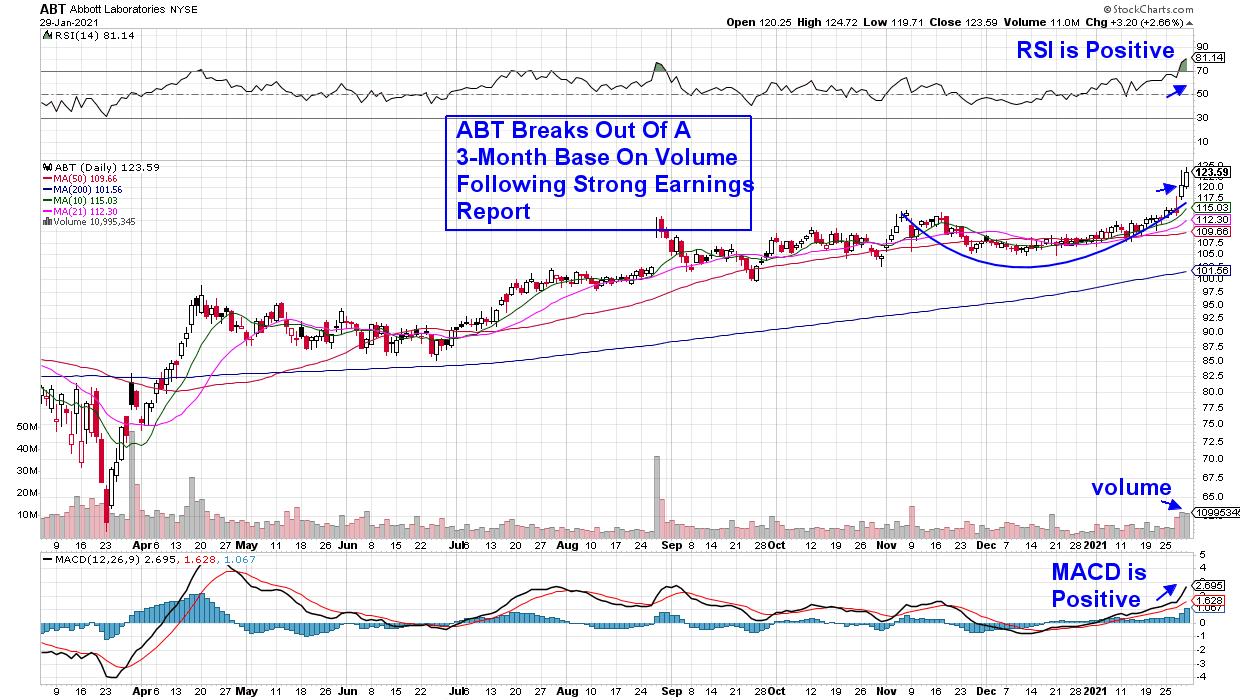
ABT posted stellar Q4 results; however, it was management's bullish guidance for sales this year that has investors excited. FDA authorization for at-home use of their tests is expected to keep testing sales high, while the company's diabetes care system will also spur growth.
Abbot's stock gapped up on heavy volume following their earnings release in a move that bullishly pushed the stock out of a 3-month base. With the RSI currently in an overbought position, we'd be a buyer on any pullback to the $118 range.
Next up is West Pharmaceutical (WST), which is a 100-year-old company that makes components for injectable drug devices that have been critical in the treatment of and vaccination against COVID-19.
DAILY CHART OF WEST PHARMACEUTICALS (WST)

The stock is poised to break out of a 1-month base ahead of the release of 4th quarter earnings early next month. And with new Medical companies unveiling positive late-stage test results for a vaccine, demand for their products is expected to remain high well into 2021.
Danaher (DHR) is another established company that's seeing strong growth due to virus-related vaccines and therapies. The company reported 63% year-over-year earnings growth last week, led by their diagnostics and life sciences divisions.
DAILY CHART OF DANAHER CORP. (DHR)

The good news is the company is expecting growth to continue higher, spurred by recent acquisitions that will provide recurring revenues due to their product mix. This is on the heels of strong sales for their 4-in-1 COVID-19 and flu test.
DHR broke back above its 50-day moving average on heavy volume following its report, and the stock is poised for a cup-with-handle breakout, with a move above $245 being even more bullish.
Among the stocks mentioned above, I'm very excited about the prospects for West Pharmaceutical (WST), as the stock was a big winner for MEM Edge Report subscribers when we added it to our Suggested Holdings List last April. WST went on to gain 86% before we removed it as a buy idea after a break below key support in October. If you'd like to be alerted to winning stocks similar to WST and many others, take a 4-week trial of my bi-weekly MEM Edge Report at a nominal fee.
In addition to expert stock selection, you'll be immediately alerted when our indicators trigger a bearish sell signal for the markets. Use this link here for immediate access to our most recent report! You can also use that link to view a sample report.
In this Friday's edition of The MEM Edge, I review the broader markets as well as underlying sectors to reveal where the weakness is and what to be on the lookout for going forward. I also present defensive stocks that are poised to trade higher, as well as names that are ignoring the markets and charging to new highs.
Warmly,
Mary Ellen McGonagle. MEM Investment Research
|
| READ ONLINE → |
|
|
|
| MORE ARTICLES → |
|
 Chart 1
Chart 1 Chart 2
Chart 2 Chart 3
Chart 3

 I've spoken recently of the
I've spoken recently of the 



































